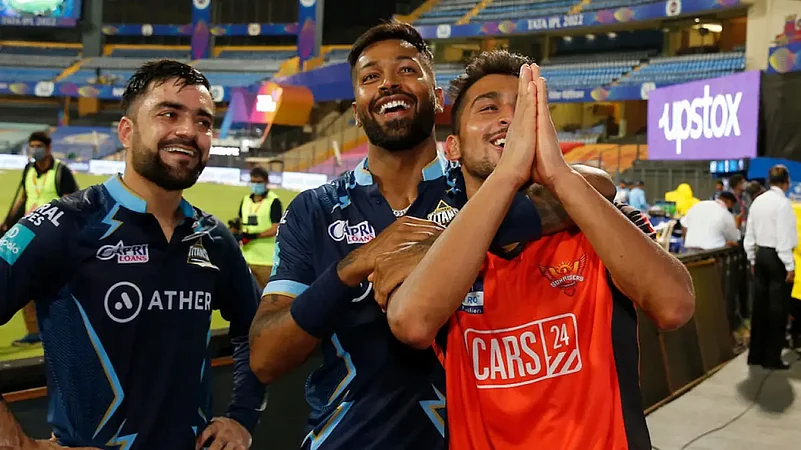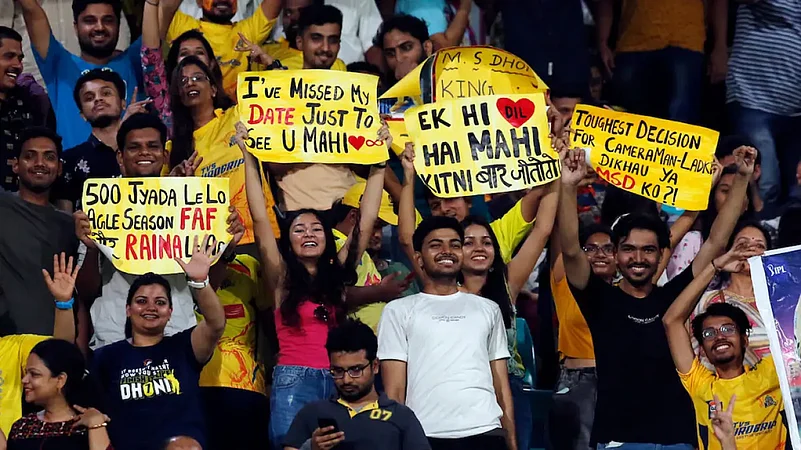The Indian Premier League 2022 is approaching its business end. Interestingly, this edition’s playoff stages will miss three of the greatest teams in the history of the competition – Mumbai Indians, Chennai Super Kings and Kolkata Knight Riders. MI, CSK and KKR have shared 10 titles among them. An IPL minus these three takes away the sheen from the world’s most popular T20 league.
The two new teams – Gujarat Titans and Lucknow Super Giants – have dominated this year’s tournament. Gujarat Titans, led by Hardik Pandya, were the first to enter the IPL playoffs. This was perhaps not expected when the tournament began. Mumbai Indians lost eight consecutive games. It was unthinkable. Chennai Super Kings lost their first four matches, ran hot and cold and finally shot themselves in their feet with their ninth defeat in 13 matches.
Just weeks away from the sale of IPL’s media rights, expected to break all records and touch anywhere between INR 40,000-50,000 Crores, the performance of the ‘Big Three’ – Mumbai, Chennai and Kolkata – may have come as a damper. There has been a decline in TV viewership but even though the latest figures were not available from the host broadcasters Star Sports, digital (OTT) viewership has been the choice of millions of cricket fans.
Outlook spoke to Bhairav Shanth, the co-founder of ITW, one of Asia’s leading sports, media and entertainment consulting firms, on Brand IPL – present and future. Excerpts from a conversation:
On A 10-team tournament — Has it lifted IPL's brand value?
It most certainly has. But it's important to keep in mind that the IPL's brand value is something that is different from the IPL's business value. There is a link between the two in the sense that when the brand value goes up, the business value goes up as well. The addition of two new franchises has helped the league get both a higher brand and business valuation. That is driven by the fact that the IPL's business ecosystem gets bigger (more brands can come under its sphere of influence by associating with these teams) and the league's prestige and standing as the preeminent brand in world cricket (more international stars, as well as exciting domestic talent, get a shot to showcase themselves on a big stage) today is reinforced.
Our research team, ITW Core, had crunched the data and made a projection that the brand value will go up by 20-25% because of the increased number of matches and a larger slate of players who will be seen in action. Duff & Phelps, who release IPL brand valuation reports every year, had also mentioned that the value of the eco-system will increase. The value was around $6.3 billion in 2020 and as per our projections, it should be around $8-8.5 billion in 2022-23.
Poor performances by Mumbai Indians, Chennai Super Kings and Kolkata Knight Riders hurting brand IPL?
It would be a bit far-fetched to say it has hurt the brand IPL. It's like questioning Lionel Messi's football career because he did not win the Ballon D'Or award this year or didn't score a goal in his last 3 league matches. Sporting performances vary and this isn’t the first time these teams have had an ordinary tournament.

The reaction so far is predictable but it's important that critics and the Indian sports media appreciate the following — The IPL started in 2008, it's now a seasoned, time-tested mature global sports league at par with the English Premier League, National Football League, UEFA Champions League and the FIFA World Cups; and if the proposed women's IPL breaks the gender bias in Indian cricket viewership, the IPL will be the world's most valued sports league within the next five years.
On Relatively lower viewership on TV and IPL media rights
Following up on the last answer, the relatively lower ratings are not reflective of IPL as a long-term viewership property is not hurt. And we also need to accommodate the fact that audiences are no longer confined to TV. The prices the BCCI has set for these new rights packages are on the basis of the new expanded format and increased inventory (greater number of games and hence more advertising slots). In fact, if anything, the BCCI this time is ahead of the curve. The Invitation To Tender (ITT) has been designed to cater to a diverse range of content needs and the evolution of the content space and its skew towards digital. Relatively lower viewership will have zero impact on sale of IPL media rights.
On OTT/Digital the way forward
Just like TV killed radio as a medium, digital and future media will do the same to conventional television. We have seen over the last three to four years a significant shift in the IPL’s reach — almost a fifth of the audience is now on OTT, up from barely single-digit percentages about five years ago. The digital audience is projected to be almost half of the viewership by 2025-26. This is also reflected in the fact that the BCCI has separated the digital rights package as a standalone bid.
The growth of a digital viewership (the OTT viewership base is likely to be around 550 million by 2024 according to a projection from Boston Consulting Group) on smartphones and CTVs also presents immense possibilities for advertisers to target their customers better and offer interactive experiences.
On big-spending online gaming companies coming under 28% GST slab
The government bringing these companies under a higher tax slab might slow their user growth and usage down in the short term but it makes no difference at all. Cricket remains a natural and organic fit in terms of advertising for these companies and the sector because their target audience overlaps hugely with the same ones who watch and engage with cricket. In fact, it might be time for the gaming industry to sponsor national sports events other than cricket. Incentivising legitimate gaming brands which are allowed to operate as per the current business laws in India will only drive more growth and awareness instead of penalising them.
In cricket sponsorship, it is important to understand that on-ground advertising is different from on-air. While on-ground opportunities are limited and believes in category exclusivity (one brand per category), there is no such exclusivity in on-air. A dozen gaming brands can advertise. It’s time online gaming companies started looking beyond cricket.
On uncertainty over Crypto and sustainability of brands like Byju’s and Cred in terms of cricket sponsorship
Byjus, Cred and other new-age tech-driven brands like Swiggy, Unacademy, MPL, etc. can sustain sponsorship. They have the kind of marketing budgets and ambitions to stay associated and committed to a long-term strategy, even at the kind of premium prices that BCCI commands. But the larger point is that if Crypto and NFTs are facing global uncertainty then it's bad news for football or maybe even F1. Not cricket.

Globally cricket is still flirting with this category and ICC is offering approvals on a case-to-case basis. BCCI is yet to officially make its position clear if Crypto brands can take up on-ground sponsorship and how they wish to explore NFT monetisation opportunities. This IPL, all leading crypto-currency exchange brands did not advertise on TV and Digital mediums. In spite of this, Disney+ Hotstar sold out its full inventory for this IPL season.
On offshore betting and gaming companies flooding the Indian market. Is that good for cricket?
It's like asking if smoking is good? Betting may be legal globally but it's not recommended and let's not forget that it is the highest taxed industry. There is a super-bubble in the making and if not regulated now, it will definitely impact the business of cricket globally in the long run.
In the 2021-22 English Premier League season, 19 out of the 20 clubs have betting brands and about two-thirds of the Championship clubs (the second division) have betting companies as sponsors. What began with Betfair and Fulham in 2002-03 is now a monster in two decades. There is massive dependence on betting brands for revenue. In the Spanish La Liga, seven clubs had a betting brand as sponsor before a ban was announced during the 2020-21 season. Now, with the UK government actively planning to ban betting brands to advertise on football team jerseys, the 2023-24 season will become a commercial struggle for clubs.
In India, betting is not allowed. So, dependency on betting brands can be suicidal. It is not good for the ecosystem because it also lifts the business of sport equilibrium artificially.
On brand appeal of new teams like Gujarat Titans and Lucknow Super Giants
This is just their first season. The other teams have had a 14-year head start. Give them time to settle in and build their teams, brand identity and appeal. This will take a few IPL cycles to develop.
On T20 cricket overkill and brand appeal of IPL
The growing cumulative audience (despite fluctuations in average viewership) is an indication that there isn’t any loss in brand appeal. It could be recency bias since it has been only six months since IPL was last held (as a consequence of the coronavirus pandemic). Things should settle down as the usual cycle resumes.

A couple of marquee players have had poor outings but there have been a lot of exciting talent emerging. Just look at a Umran Malik, or Ayush Badoni, or even the resurgence of experienced hands like Dinesh Karthik, Kuldeep Yadav and Yuzvendra Chahal. So, there’s enough narrative depth. But it’s possible that IPL is missing a bit of its localised appeal — the buzz created in the cities where it is staged, or on-ground events such as fan parks that whip up fan interest - since the pandemic has restricted the tournament to just one or two venues. All of these will change in 2023.

















